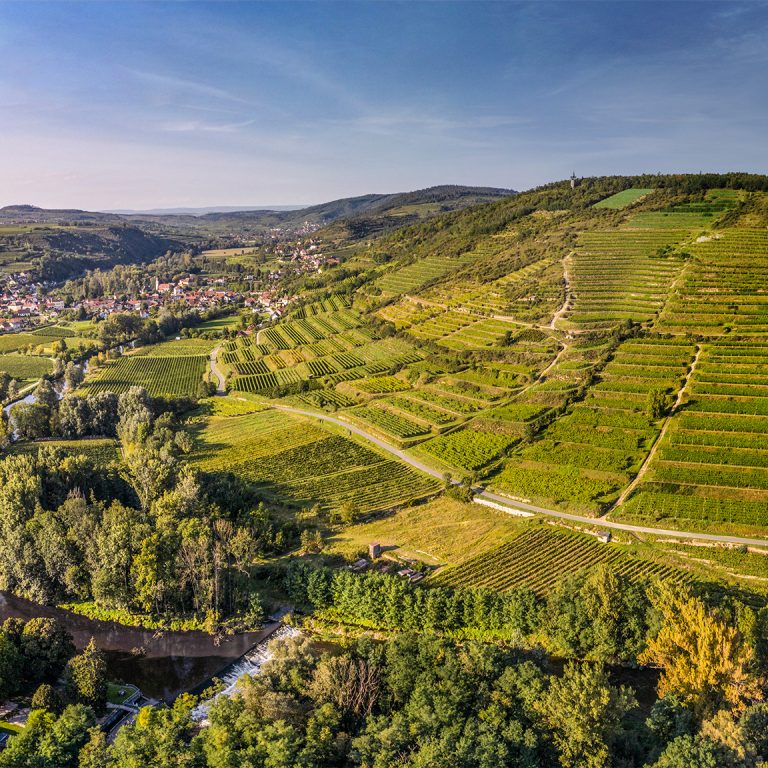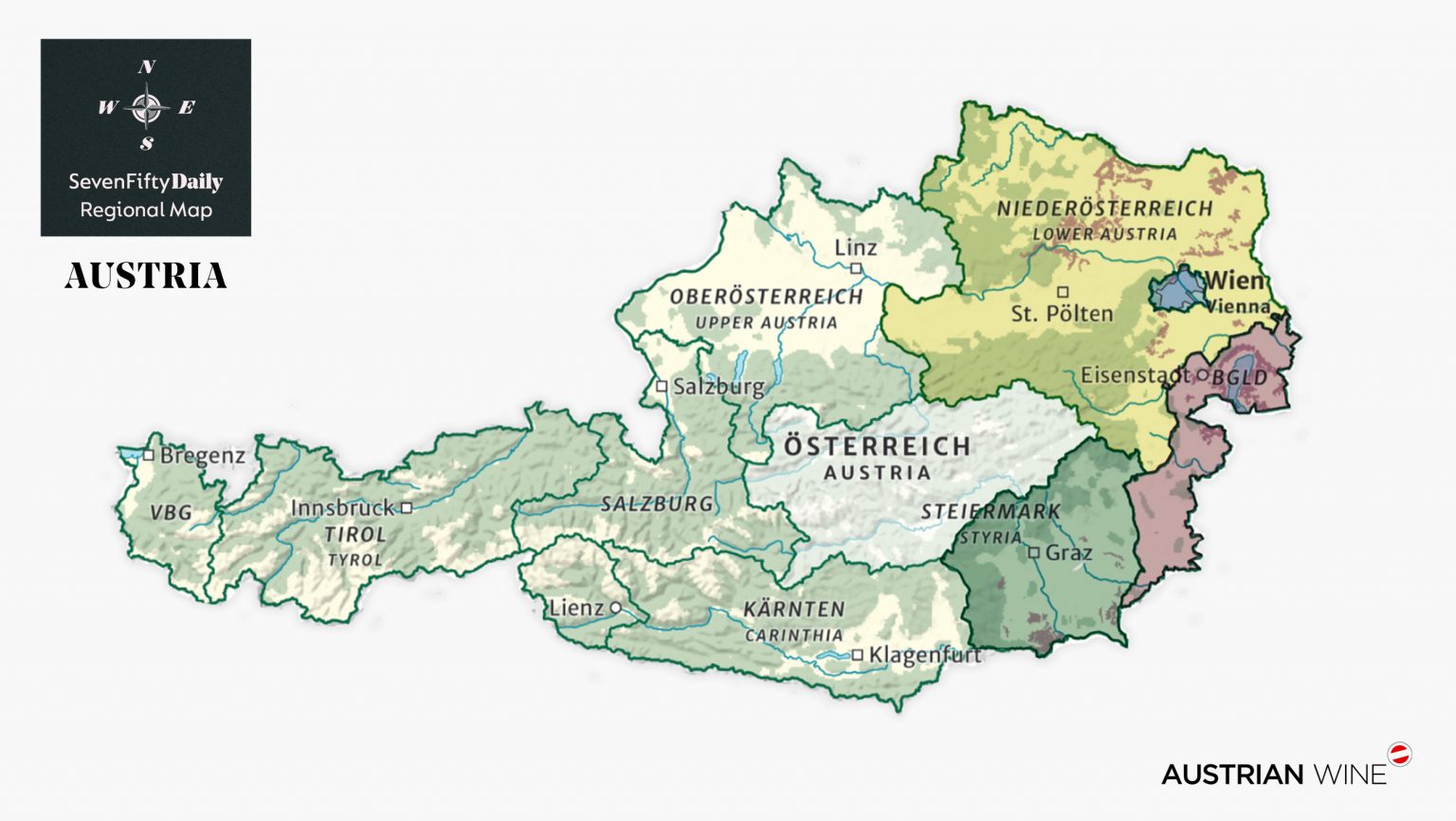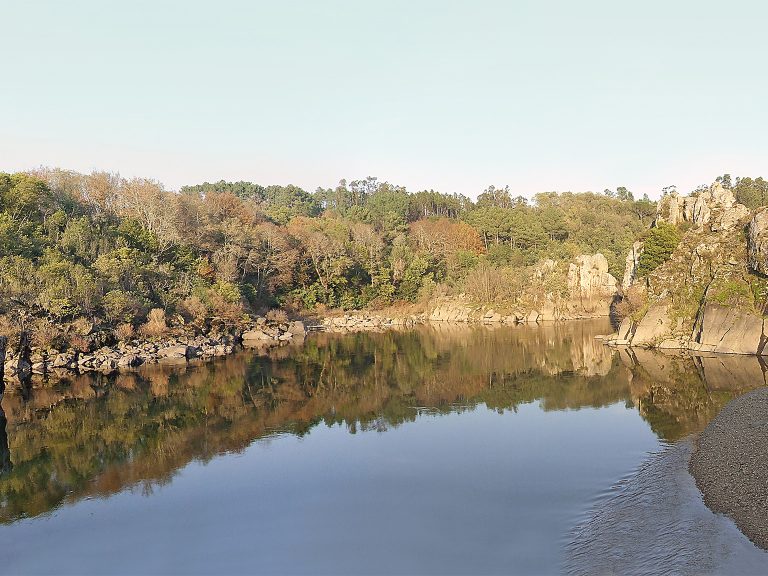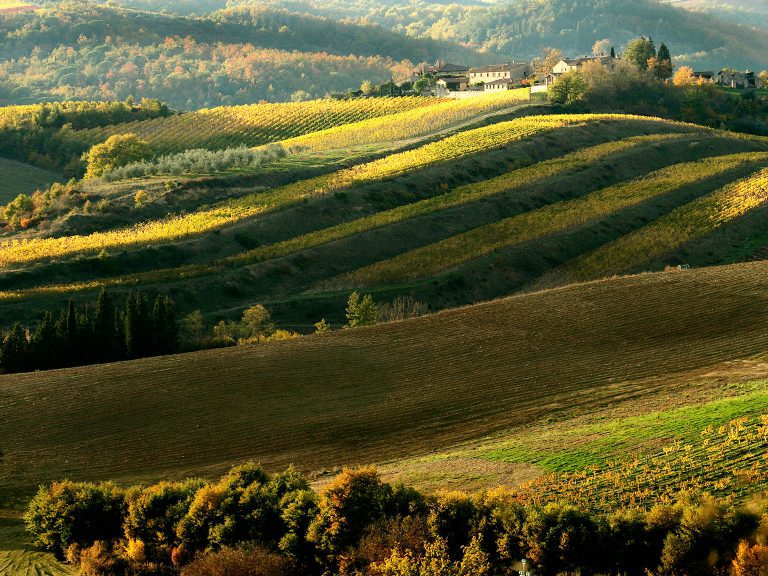This advertising content was produced in collaboration with our partner, Austrian Wine.
Austria’s mountainous countryside gives way to the expansive Pannonian Plain, where most of the country’s wine is made. The majority of Austria’s vineyards span the eastern edge of the country, along the Czech, Slovakian, Hungarian, and Slovenian borders. The wine regions are all relatively close to the capital city of Vienna. Compared with other internationally renowned wine countries, the viticultural area in Austria is fairly small, but its size doesn’t hold the country back from turning out exceptionally high-quality wines across the board.
After struggling with a number of setbacks throughout its winemaking history, Austria has spent the past several decades tightening up its wine laws, implementing some of the world’s strictest quality standards, and working to restore its winemaking integrity. These efforts have yielded positive results. Austria is once again recognized as a leading producer of elegant wines made from international varieties—such as Riesling and Pinot Noir—and local grapes like Grüner Veltliner, Zweigelt, and Blaufränkisch, with a spectrum of offerings ranging from bone-dry wines to lusciously sweet ones.
Austria’s wine laws were originally based on the German system and featured two overarching categories: Qualitätswein (made up mostly of dry wines) and Prädikatswein (comprising mostly sweet wines)—with an additional Prädikat category, Ausbruch, that primarily pertains to sweet dessert wines made from botrytized grapes, most commonly in the area of Rust in Neusiedlersee.

Don’t miss the latest drinks industry news and insights. Sign up for our award-winning newsletters and get insider intel, resources, and trends delivered to your inbox every week.
However, recently Austria has been transitioning to an appellation system that’s more like France’s AOC system. Rather than focusing on the ripeness levels of the grapes at harvest, the Districtus Austriae Controllatus (DAC) appellation system focuses on terroir, permitting only select varieties, limiting alcohol levels, and defining specific guidelines for the individual styles of each region.
Approximately two-thirds of Austria’s vineyards are planted with white grapes. The majority of them are devoted to the country’s prized Grüner Veltliner variety, but recently plantings of red grape varieties have been on the rise.
Geography
The majority of Austria’s wine regions are located east of the Alps, along the borders of the Czech Republic, Slovakia, Hungary, and Slovenia. There are 46,000 hectares under vine, and in 2016, they produced a yield of 42 hectoliters per hectare.
Vineyard topography ranges from steep slopes and valleys to rolling hills and terraces. Soil types vary from stony to sandy to loamy. Approximately 70 percent of the vineyards are planted on unconsolidated rock substrates that contain calcareous loess, sandy gravels, rock debris from river terraces, and sandy and clay silts. The remaining 30 percent are planted in soils from consolidated rocks containing acidic granites, gneisses, schists, quartzites, basic amphibolites, serpentinites, basalts, marbles, limestone, conglomerates, sandstones, and volcanic tuffs.
Austria has a Central European continental climate that’s influenced by the country’s proximity to the Alps. Typically, winters are short and cold, springs are temperate and can be rainy at times, summers are long and hot, and autumns are long, with warm days and cool nights. When there is sufficient humidity during the ripening season, the botrytis necessary for making many of Austria’s specialty dessert wines is produced. There are several climatic subzones within Austria, including the Danube area, with its diurnal shifts; Weinviertel, with its dry microclimate; the Pannonian area, with its warmth and humidity; Steiermark, with its cooler alpine climate; and the Bergland with its Atlantic climate.
History
From the time that Vitis vinifera grapes were introduced by the Celts—and likely their Illyrian predecessors—around 700 BC up to the present, viticulture has been a fact of life in Austria, home to one of the world’s oldest and most historic wine cultures. The Romans, Charlemagne, and the Cistercians all contributed to the country’s wine advancement through the centuries.
By the 15th and 16th centuries, the number of Austria’s vineyards peaked, and the total area under vine was as much as three times the total acreage that exists today. Austrian winemaking was further revitalized in the 18th century under the rule of Joseph II, when the country’s Buschenschank legislation was enacted, allowing vintners to sell their wine on their own premises, paving the way for the Heurigen and Buschenschank wine taverns that remain popular in Austria today.
In 1907, having sufficiently recovered from the previous century’s phylloxera epidemic, the first Austrian law regarding the production of wine was introduced. In addition to specifying requirements for producing wines, the law also prohibited the fabrication of artificial wines.
In the 20th century, the devastation of the two world wars wreaked havoc on the country’s wine industry, resulting in a protracted effort at revival over the four decades after World War II. During this time, Grüner Veltliner emerged as the country’s national grape. Following a major scandal involving Burgenland dessert wines in the late 1980s, Austria began implementing strict quality control standards that paved the way for the international prestige that Austrian wines enjoy today. A complete breakdown of Austria’s wine vintages— including detailed notes of each growing season dating back to 1992—offers a comprehensive picture of the country’s modern winemaking era.
Key Regions
Austria comprises nine federal states, four of which are also major wine-growing regions. Together, they account for the incredible diversity of styles—from dry to sweet, still to sparkling, red, white, rosé, and every stylistic register in between—that makes Austria one of the premier wine-producing nations on Earth.
Vienna
Most visitors to Vienna don’t realize that the city limits contain one of Austria’s four major wine regions. Far from a tourist attraction or novelty, Vienna enjoys the distinction of being the only major European capital to possess a fully-fledged commercial wine industry, with over 540 hectares currently planted under vine.
Mostly centered around the outskirts of the city, the area produces plenty of crisp, fragrant varietal wines from grapes as varied as Grüner Veltliner, Riesling, Weissburgunder, and Chardonnay, among others. But Vienna’s most traditional local expression is unquestionably Wiener Gemischter Satz, the area’s traditional co-planted, co-harvested field blend of native grapes that predates the arrival of monoculture by centuries. The traditional tipple of the local Heuriger, or Viennese wine tavern, where it has been continuously enjoyed by generations of locals, the style is now enjoying a vibrant 21st-century renaissance, with many high-quality examples being exported to foreign markets for the first time.
Niederösterreich
Commonly translated to “Lower Austria” and spanning no fewer than eight sub-zones, Niederösterreich is Austria’s largest winegrowing region for Qualitätswein. The area’s incredible stylistic diversity makes it resistant to simple generalizations, but can be conveniently divided into three main climatic zones: the Weinviertel in the north (where the Grüner Veltliner grape is king), the Danube River Region to the west of Vienna, and Pannonian Niederösterreich to the southeast, each of which possesses its own unique subset of appellations.
Though each of these sub-zones possesses its own distinct stylistic identity, the area owes its international acclaim to classic, age-worthy expressions of Riesling and Grüner Veltliner from the legendary single-vineyard sites of the Wachau, Kamptal, and Kremstal regions (aka, holy ground to Austrian wine lovers), which first brought the nation fame centuries ago. Though more recently arrived on the global stage, the vast Weinviertel area produces its own signature style of Grüner, notable for its raciness and mineral precision, whereas the warmer, southerly Thermenregion is ground zero for some of Austria’s greatest reds.
Burgenland
Located on the border with Hungary, Burgenland’s historical celebrity rests upon the excellence of its unctuous, nobly sweet dessert wines that flourish along the scenic Lake Neusiedl, one of the rare viticultural areas where climatic conditions are just right for the development of botrytis. While the region still churns out some of the world’s greatest, nectar-like expressions, Burgenland has more recently emerged as the epicenter of Austria’s new wave of showstopping reds. In particular, the Blaufränkisch grape continues to gain star power for rich and earthy yet surprisingly refreshing reds with a profound potential to age, plus others like Pinot Noir, Zweigelt, and St. Laurent—all of which are quickly overturning the conventional view of Austria as primarily a white-wine-producing nation.
Styria
One of Austria’s great hidden gems is the unassuming region of Styria (Steiermark to locals), a bucolic patchwork of rolling hillside vineyards surrounding the city of Graz near the Slovenian border. Here, the cool, Alpine climate yields vibrant wines that assume a substantially different character from the rest of Austria’s offerings, defined by remarkable lightness, freshness, and mineral precision.
Comprised of both indigenous and international examples, the area’s miscellaneous treasure trove of grapes includes Welschriesling (Styria’s most widely planted variety), Sauvignon Blanc (a specialty of the Südsteiermark sub-region, where it has thrived since the early 19th century), Traminer, Chardonnay (often labeled as Morillon), and Weissburgunder, among others. No overview of Styria would be complete, however, without paying homage to the hyper-local delicacy known as Schilcher, the Weststeiermark zone’s piercingly bright, high-acid style of rosé made from the indigenous Blauer Wildbacher grape. Exclusive to the area, it ranks among the most distinctive pink wines in existence.
To learn more about the origin of Austrian wines, visit austrianvineyards.com, the world’s first digital wine atlas covering an entire wine-producing country, with details on over 4,000 single vineyards.
Key Appellations
Introduced in 2002, Austria’s DAC system focuses on the regional typicity of the grapes used to produce the wine. As of March 2023, 16 specific winegrowing regions have legally been granted with 17 DACs (the specific winegrowing region Leithaberg has Leithaberg DAC and Ruster Ausbruch DAC) by the Ministry of Agriculture. Each one abides by a specific set of regulations and grape classifications to meet the designation’s standards of regional typicity and quality control; all other wines are labeled under the name of the federal state they’re grown in.
All DAC wines fall into the Qualitätswein category. Within some DACs, vintners may label their wines as Klassik (unchaptalized, medium-bodied dry wines with a minimum 12% ABV) or Reserve (richer, full-bodied wines with higher must rates, a minimum 13% ABV, and in some cases, discernible residual sugar). Today, more DAC producers are classifying their wines with more specific designations of origin: Gebietswein (regional wine), Ortswein (“village” wine), and Riedenwein (single-vineyard wine).
Wachau DAC
A UNESCO World Heritage Site, the Wachau is widely regarded as Austria’s most iconic wine region, known for the steely concentration and structured depth of its celebrated single-vineyard expressions (aka “Reidenwein”) of Riesling and Grüner Veltliner, the area’s two flagship grapes. The area still uses its famous three-tier ripeness classification system, ranging in ripeness from the bright, fresh Steinfeder, to the middleweight Federspiel category, and, finally, the rich, full-bodied Smaragd wines that rank among Austria’s most prized possessions.
Kremstal DAC
Just east of the Wachau along the banks of the Danube, surrounding the storied city of Krems, Kremstal also specializes in world-class Rieslings and Grüner Veltliners that display the chiseled minerality of the area’s steep, terraced, south-facing hillside slopes. Stylistically similar to the opulent, show-stopping wines of the Wachau, they possess the same remarkable synthesis between ripeness and racy acidity—a product of the warmth of the Pannonian Plain and the cooling mountain air from the Alps.
Kamptal DAC
Boasting its own fair share of classic estates and celebrated vineyards, the Kamptal area surrounding the city of Langenlois also specializes in show-stopping white wines from Riesling and Grüner Veltliner that rival any of the nation’s best, including the nearby Wachau.
Traisental DAC
Traisental is not only one of Austria’s smallest regions, with just 851 hectares under vine, but also its newest, only existing in its current form since 1995. Still, it’s quickly making a name for itself thanks to the charm of its spicy Grüner Veltliners and racy Rieslings grown on gravel and limestone soils, to say nothing of its charming villages and tourist-friendly wine taverns.
Wagram DAC
In this region, the vineyards are divided between two distinctly different zones. The first zone, north of the Danube, lies directly to the east of the Kamptal. The second zone, south of the Danube, home to the small wine villages of the Tulln Basin, as well as the historic wine-growing town of Klosterneuburg, is just a stone’s throw away from Vienna. The white wines, which are often shaped by their loess soils, are admired for their subtle spiciness and can be made from Grüner Veltliner, Riesling, or Roter Veltliner. Some of Niederösterreich’s richest red wines are also produced by the leading wineries here, specifically from Zweigelt, Sankt Laurent and Blauburgunder.
Weinviertel DAC
As you’d expect from Austria’s largest winegrowing region (at over 14,000 hectares under vine), the Weinviertel home is home to an impressively large range of grapes, but Grüner Veltliner takes center stage. In fact, with its strong, peppery regional character, Grüner from the Weinviertel was the first Austrian wine to acquire DAC status back in 2003.
Carnuntum DAC
Among Austria’s most diverse viticultural zones, Carnuntum—running from the east of Vienna to the Slovakian border—excels at chiseled, structured whites from grapes like Grüner Veltliner, Chardonnay, and Pinot Blanc, but it’s actually better known for its ability to ripen outstanding reds from Zweigelt and Blaufränkisch grapes.
Neusiedlersee DAC
Just a half-hour’s drive southeast of Vienna, in the northernmost part of Burgenland, Neusiedlersee has been praised for centuries for its unctuously powerful, sticky-sweet dessert wines, painstakingly crafted from botrytized Welschriesling grapes, but more recently it has emerged as stronghold for Zweigelt-based reds that range from fun and fruit-forward to powerful yet velvety Reserve examples.
Leithaberg DAC
From another Burgenland subzone that is defined above all by its dazzling diversity, Leithaberg’s whites (produced from the varieties Weissburgunder, Chardonnay, Neuburger, and Grüner Veltliner) and Blaufränkisch-based reds all share the same structural tension, elegance, and mineral backbone, thanks to the area’s fossilized limestone soils.
Ruster Ausbruch DAC
Tucked inside the greater Leithaberg sub-region, the famous town of Rust yields characteristically bright, mineral-driven dry whites and reds (labeled under the Leithaberg DAC), but its greatest claim to fame has always been the nobly sweet Ruster Ausbruch, one of the world’s legendary nobly sweet dessert wines protected by its own DAC since 2020.
Rosalia DAC
Though Celtic tribes first brought viticulture to the area more than 2,500 years ago, in modern times Rosalia has emerged as a leader in the production of Blaufränkisch (the grape alone accounts for over 60 percent of the vines), which it channels not only into powerful reds but plenty of charmingly fruity rosé as well.
Mittelburgenland DAC
Encompassing the beating heart of Austria’s red wine culture, Mittelburgenland has become known among locals as “Blaufränkischland,” which tells you all you need to know about the area’s special knack for the grape. In fact, many consider the versions from Mittelburgenland to be grape’s archetypal expression, defined by brambly wild-berry freshness, deep violet hue, and characteristic spice.
Eisenberg DAC
At the southernmost edge of Burgenland, the tiny, rural region of Eisenberg has historically sold most of its production via its idyllic wine taverns. In 2008, however, it received its richly deserved DAC status for charming, well-balanced reds produced exclusively from Blaufränkisch, notable for their cherry-like fruit, freshness, and earthy minerality.
Vulkanland Steiermark DAC
One of Styria’s three official DACs, the aptly-titled Vulkanland derives its name from the slopes of extinct volcanoes that its vineyards call home, which impart a distinct profile to its wines made from a distinct grab-bag of grapes, including Welschriesling, Morillon (Chardonnay), Weissburgunder (Pinot Blanc), Grauburgunder (Pinot Gris), Gelber Muskateller, Sauvignon Blanc, and Riesling, to say nothing of the rose-petal-scented Traminer, arguably the local specialty.
Südsteiermark DAC
A green oasis of steep rolling hillside vineyards that make manual harvesting a necessity, Südsteirmark offers an ideal introduction to the freshness and elegance that characterize Styria as a whole, including a completely singular take on Sauvignon Blanc that ranges from fresh Klassik expressions to profound single-vineyard wines. Other permitted varieties include Sauvignon Blanc, Muskateller, Weissburgunder, Morillon, and Riesling.
Weststeiermark DAC
Occupying the western portion of Styria (as its name would suggest), Weststeiermark is best known to locals as the birthplace of pink-hued Schilcher, produced from the ancient Blauer Wildbacher variety. Once a rustic country wine defined by in-your-face acidity, in modern times it has been tamed into a delightfully racy, zingy style of rosé that is the unique expression of its Styrian terroir.
Wiener Gemischter Satz DAC
The archetypal field-blend of the Heuriger, Vienna’s centuries-old wine taverns, Gemischter Satz, meaning “mixed set,” has been grown in the hillsides outside the nation’s capital for generations, fueling a vibrant local culture. Co-harvested and fermented by law, permitted grapes include Grüner Veltliner, Riesling, Weissburgunder, and Chardonnay.
Key Grape Varieties
The key to Austrian wine’s greatness is the diversity of grape varieties, both indigenous and international, that call the country’s vineyards home. Though hardly a comprehensive list, here are just a few of the main players that contribute to the brilliant spectrum of styles that Austria now offers to audiences across the globe.
Grüner Veltliner
Austria’s most widely planted grape accounts for over one-third of all the country’s vineyard plantings, which equates to approximately 14,614 hectares. Plantings are particularly concentrated in the areas of Niederösterreich and northern Burgenland. Grüner Veltliner gives versatile wines with distinctive minerality and green vegetable, stone fruit, herbaceous, and peppery notes; it can also develop honeyed, toasty notes with age. Styles range from light-bodied, low-alcohol, dry wines (including young heurigen wines and base wines for Sekt—Austria’s sparkling) to fuller-bodied, higher-alcohol dry and viscous sweet wines.
Riesling
While Riesling accounts for less than five percent of Austria’s vineyard plantings (2,023 hectares), it is the country’s second-most important variety—and the most significant white variety in the Wachau. It grows well in rich, rocky soils along the Danube River and its tributaries. Austrian Rieslings are full-bodied and almost always dry, with characteristic acidity and ripe peach, apricot, and tropical fruit notes. Those from the Wachau, Kremstal, Kamptal, and Traisental regions offer slate and flinty mineral notes. As they age, Austrian Rieslings develop greater complexity and can take on distinctive rose and petrol notes. Late-harvest botrytized grapes yield outstanding Auslese and Beerenauslese wine styles.
Zweigelt
Originally called Rotburger, Austria’s most widely planted red grape is a crossing of Blaufränkisch and St. Laurent. The hybrid was created in 1922 and designed for higher yields and early ripening. (The original name presented some challenges in English-speaking markets, so the grape was later renamed after its creator, Fritz Zweigelt.) It accounts for 6,230 hectares (approximately 14 percent) of Austria’s vineyards. Zweigelt yields a range of styles, from fruity, unoaked wines that are meant to be drunk young to mature, full-bodied wines that are aged in barrique. Zweigelt is typically violet-red in color with soft tannins and characteristic cherry and black pepper notes.
Blaufränkisch
Considered Austria’s signature red grape, Blaufränkisch is the country’s second-most widely planted red variety and can be found in the highest concentrations in Burgenland and in eastern Niederösterreich. There are approximately 2,632 hectares of Blaufränkisch (5.9 percent) in Austria’s vineyards. It’s a late-ripening variety that produces wines with moderate tannins, high acidity, and notable minerality. Red berries and cherry are the dominant flavor notes, but the wines are also known for their spicy character.
Others
Many other varieties can be found growing in Austria, including Weissburgunder (Pinot Blanc), Chardonnay, Muskateller, Traminer, Furmint, St. Laurent, Pinot Noir, Merlot, Cabernet Sauvignon, Syrah, Neuburger, Rotgipfler, Zierfandler, Roter Veltliner, Blauer Wildbacher, and the field blend known as Gemischter Satz. More information on the grape varieties can be found on the Austrian Wine website.
A Brief Word on Sekt
Given Austria’s reputation for technical precision and its national talent for racy, elegant, high-acid wines, it should come as no surprise that the country has become an incubator for world-class sparkling wines. Locally known as Sekt, the German term for bubbly wine, the best of Austria’s versions utilize the traditional-method of secondary fermentation in bottle with the goal of expressing a uniquely Austrian sense of place.
The Sekt g.U., or PDO, was introduced in 2015 to guarantee quality and origin standards and includes three quality levels: Klassik, Reserve, and Grosse Reserve. Only Sekt g.U. wines may list these quality designations on their labels, and they can be recognized by the red-white-red banderole on the capsule.
Today, the style is undergoing a dazzling 21st-century renaissance, but Austrian sparkling wine is nothing new. In fact, the country’s history with the style dates back to 1842, when Robert Alwin Schlumberger—at the time, the cellarmaster of the historic Ruinart champagne house—married the daughter of wealthy Viennese industrialist and relocated to Austria to found the country’s first major sparkling wine house. With up to 40 permitted grape varieties to draw from, the sheer range of sparkling styles on display rivals that of any bubbly-producing region on earth.
What’s Happening in Austria Today?
Austria’s international reputation for winemaking is booming. The country’s wines are sought after for inclusion on prestigious wine lists worldwide. Despite its world-famous status, Austria’s winemaking community is rather small—and mostly made up of small producers. There are approximately 20,000 winegrowers in the country, including 6,000 who are considered bottlers.
Austria is now seeing a new generation of young, highly educated oenologists taking over their family estates. As a result, it’s becoming common for older winemakers to step back from the management of vineyards and cellars and to take on ambassadorial roles.
Red grape plantings are also steadily increasing throughout the country, and indigenous red varieties like Blaufränkisch, Zweigelt, and St. Laurent are coming into fashion, as are natural wines created from organic and biodynamic farming. In fact, coinciding with the country’s rise as a hotbed of naturalist activity, Austria has recently enacted a nationwide shift toward greater environmental awareness, emerging as an industry leader in the areas of low-impact winemaking and eco-friendly viticulture.
Evidence of this generational change has manifested in each of Austria’s wine regions, where a new wave of forward-thinking winemakers continues to deepen this commitment to sustainability, with an increasing number of them now practicing integrated, organic, and biodynamic farming in order to promote biodiversity and ensure the health of their soils. Bringing this trend to a culmination, after several years of pioneering research, the country recently introduced its own internal certification system for sustainability, Sustainable Austria. Implemented in 2015, the system currently offers winegrowers the tools to gauge their own ecological impact and provides specific guidelines for future advancement and progress.
For those eager to explore the country’s vineyards in greater detail, there’s good news. After three years of development, Austrian Wine (in cooperation with the University of Vienna) recently launched the Austrian Vineyard Viewer, the world’s first digital wine atlas covering an entire wine-producing nation, providing curious drinkers with an unparalleled tool for further exploration and discovery.










